Hua Yang
3D Vision-tactile Reconstruction from Infrared and Visible Images for Robotic Fine-grained Tactile Perception
Jun 18, 2025Abstract:To achieve human-like haptic perception in anthropomorphic grippers, the compliant sensing surfaces of vision tactile sensor (VTS) must evolve from conventional planar configurations to biomimetically curved topographies with continuous surface gradients. However, planar VTSs have challenges when extended to curved surfaces, including insufficient lighting of surfaces, blurring in reconstruction, and complex spatial boundary conditions for surface structures. With an end goal of constructing a human-like fingertip, our research (i) develops GelSplitter3D by expanding imaging channels with a prism and a near-infrared (NIR) camera, (ii) proposes a photometric stereo neural network with a CAD-based normal ground truth generation method to calibrate tactile geometry, and (iii) devises a normal integration method with boundary constraints of depth prior information to correcting the cumulative error of surface integrals. We demonstrate better tactile sensing performance, a 40$\%$ improvement in normal estimation accuracy, and the benefits of sensor shapes in grasping and manipulation tasks.
MTIL: Encoding Full History with Mamba for Temporal Imitation Learning
May 18, 2025Abstract:Standard imitation learning (IL) methods have achieved considerable success in robotics, yet often rely on the Markov assumption, limiting their applicability to tasks where historical context is crucial for disambiguating current observations. This limitation hinders performance in long-horizon sequential manipulation tasks where the correct action depends on past events not fully captured by the current state. To address this fundamental challenge, we introduce Mamba Temporal Imitation Learning (MTIL), a novel approach that leverages the recurrent state dynamics inherent in State Space Models (SSMs), specifically the Mamba architecture. MTIL encodes the entire trajectory history into a compressed hidden state, conditioning action predictions on this comprehensive temporal context alongside current multi-modal observations. Through extensive experiments on simulated benchmarks (ACT dataset tasks, Robomimic, LIBERO) and real-world sequential manipulation tasks specifically designed to probe temporal dependencies, MTIL significantly outperforms state-of-the-art methods like ACT and Diffusion Policy. Our findings affirm the necessity of full temporal context for robust sequential decision-making and validate MTIL as a powerful approach that transcends the inherent limitations of Markovian imitation learning
Envisioning Beyond the Pixels: Benchmarking Reasoning-Informed Visual Editing
Apr 03, 2025Abstract:Large Multi-modality Models (LMMs) have made significant progress in visual understanding and generation, but they still face challenges in General Visual Editing, particularly in following complex instructions, preserving appearance consistency, and supporting flexible input formats. To address this gap, we introduce RISEBench, the first benchmark for evaluating Reasoning-Informed viSual Editing (RISE). RISEBench focuses on four key reasoning types: Temporal, Causal, Spatial, and Logical Reasoning. We curate high-quality test cases for each category and propose an evaluation framework that assesses Instruction Reasoning, Appearance Consistency, and Visual Plausibility with both human judges and an LMM-as-a-judge approach. Our experiments reveal that while GPT-4o-Native significantly outperforms other open-source and proprietary models, even this state-of-the-art system struggles with logical reasoning tasks, highlighting an area that remains underexplored. As an initial effort, RISEBench aims to provide foundational insights into reasoning-aware visual editing and to catalyze future research. Though still in its early stages, we are committed to continuously expanding and refining the benchmark to support more comprehensive, reliable, and scalable evaluations of next-generation multimodal systems. Our code and data will be released at https://github.com/PhoenixZ810/RISEBench.
Lightweight Multimodal Artificial Intelligence Framework for Maritime Multi-Scene Recognition
Mar 10, 2025Abstract:Maritime Multi-Scene Recognition is crucial for enhancing the capabilities of intelligent marine robotics, particularly in applications such as marine conservation, environmental monitoring, and disaster response. However, this task presents significant challenges due to environmental interference, where marine conditions degrade image quality, and the complexity of maritime scenes, which requires deeper reasoning for accurate recognition. Pure vision models alone are insufficient to address these issues. To overcome these limitations, we propose a novel multimodal Artificial Intelligence (AI) framework that integrates image data, textual descriptions and classification vectors generated by a Multimodal Large Language Model (MLLM), to provide richer semantic understanding and improve recognition accuracy. Our framework employs an efficient multimodal fusion mechanism to further enhance model robustness and adaptability in complex maritime environments. Experimental results show that our model achieves 98$\%$ accuracy, surpassing previous SOTA models by 3.5$\%$. To optimize deployment on resource-constrained platforms, we adopt activation-aware weight quantization (AWQ) as a lightweight technique, reducing the model size to 68.75MB with only a 0.5$\%$ accuracy drop while significantly lowering computational overhead. This work provides a high-performance solution for real-time maritime scene recognition, enabling Autonomous Surface Vehicles (ASVs) to support environmental monitoring and disaster response in resource-limited settings.
OmniAlign-V: Towards Enhanced Alignment of MLLMs with Human Preference
Feb 25, 2025Abstract:Recent advancements in open-source multi-modal large language models (MLLMs) have primarily focused on enhancing foundational capabilities, leaving a significant gap in human preference alignment. This paper introduces OmniAlign-V, a comprehensive dataset of 200K high-quality training samples featuring diverse images, complex questions, and varied response formats to improve MLLMs' alignment with human preferences. We also present MM-AlignBench, a human-annotated benchmark specifically designed to evaluate MLLMs' alignment with human values. Experimental results show that finetuning MLLMs with OmniAlign-V, using Supervised Fine-Tuning (SFT) or Direct Preference Optimization (DPO), significantly enhances human preference alignment while maintaining or enhancing performance on standard VQA benchmarks, preserving their fundamental capabilities. Our datasets, benchmark, code and checkpoints have been released at https://github.com/PhoenixZ810/OmniAlign-V.
MG-LLaVA: Towards Multi-Granularity Visual Instruction Tuning
Jun 25, 2024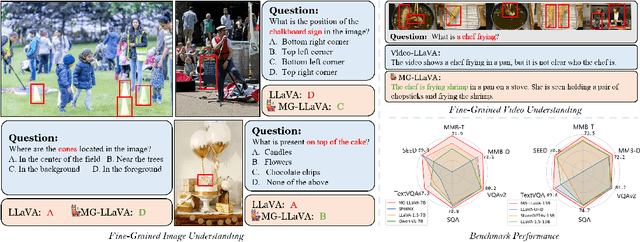
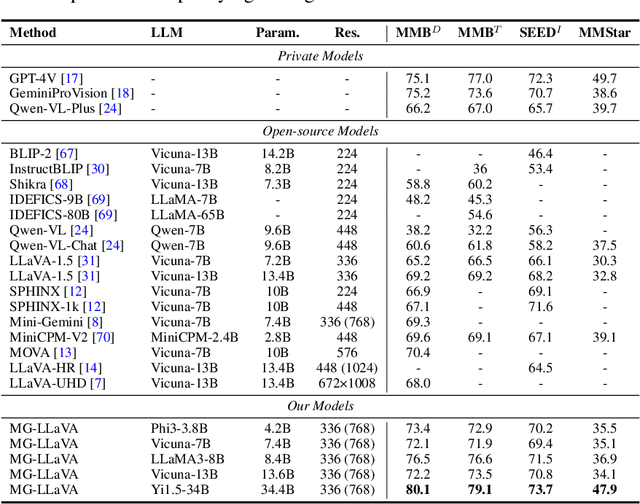

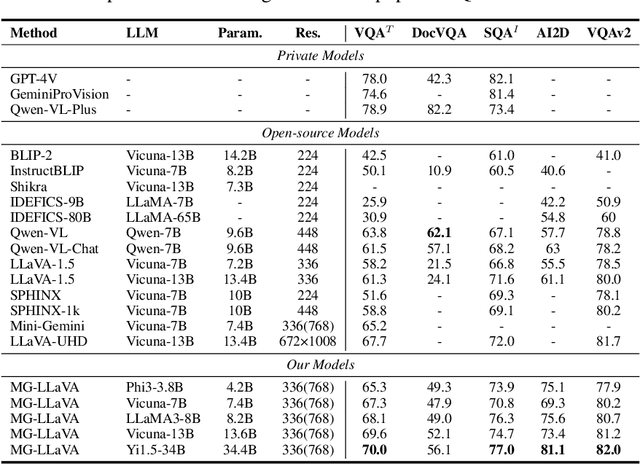
Abstract:Multi-modal large language models (MLLMs) have made significant strides in various visual understanding tasks. However, the majority of these models are constrained to process low-resolution images, which limits their effectiveness in perception tasks that necessitate detailed visual information. In our study, we present MG-LLaVA, an innovative MLLM that enhances the model's visual processing capabilities by incorporating a multi-granularity vision flow, which includes low-resolution, high-resolution, and object-centric features. We propose the integration of an additional high-resolution visual encoder to capture fine-grained details, which are then fused with base visual features through a Conv-Gate fusion network. To further refine the model's object recognition abilities, we incorporate object-level features derived from bounding boxes identified by offline detectors. Being trained solely on publicly available multimodal data through instruction tuning, MG-LLaVA demonstrates exceptional perception skills. We instantiate MG-LLaVA with a wide variety of language encoders, ranging from 3.8B to 34B, to evaluate the model's performance comprehensively. Extensive evaluations across multiple benchmarks demonstrate that MG-LLaVA outperforms existing MLLMs of comparable parameter sizes, showcasing its remarkable efficacy. The code will be available at https://github.com/PhoenixZ810/MG-LLaVA.
MCSD: An Efficient Language Model with Diverse Fusion
Jun 18, 2024



Abstract:Transformers excel in Natural Language Processing (NLP) due to their prowess in capturing long-term dependencies but suffer from exponential resource consumption with increasing sequence lengths. To address these challenges, we propose MCSD model, an efficient language model with linear scaling and fast inference speed. MCSD model leverages diverse feature fusion, primarily through the multi-channel slope and decay (MCSD) block, to robustly represent features. This block comprises slope and decay sections that extract features across diverse temporal receptive fields, facilitating capture of both local and global information. In addition, MCSD block conducts element-wise fusion of diverse features to further enhance the delicate feature extraction capability. For inference, we formulate the inference process into a recurrent representation, slashing space complexity to $O(1)$ and time complexity to $O(N)$ respectively. Our experiments show that MCSD attains higher throughput and lower GPU memory consumption compared to Transformers, while maintaining comparable performance to larger-scale language learning models on benchmark tests. These attributes position MCSD as a promising base for edge deployment and embodied intelligence.
Exploring Interactive Semantic Alignment for Efficient HOI Detection with Vision-language Model
Apr 19, 2024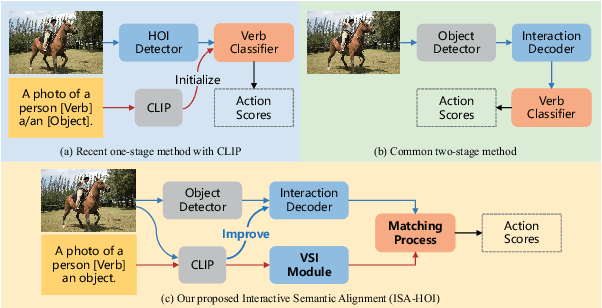
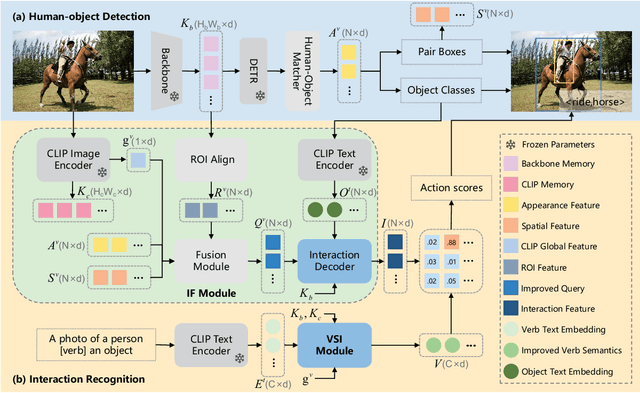
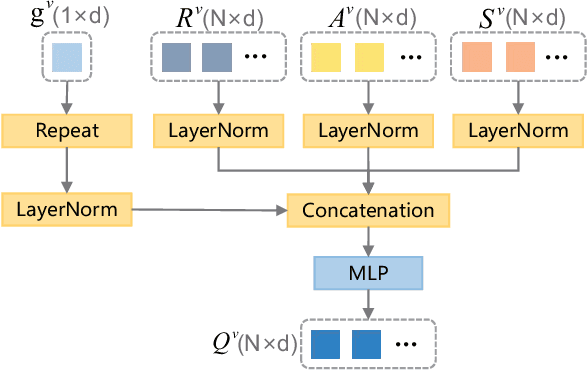
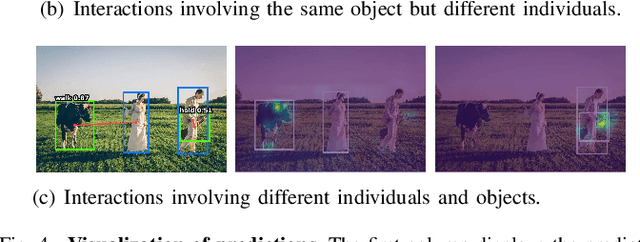
Abstract:Human-Object Interaction (HOI) detection aims to localize human-object pairs and comprehend their interactions. Recently, two-stage transformer-based methods have demonstrated competitive performance. However, these methods frequently focus on object appearance features and ignore global contextual information. Besides, vision-language model CLIP which effectively aligns visual and text embeddings has shown great potential in zero-shot HOI detection. Based on the former facts, We introduce a novel HOI detector named ISA-HOI, which extensively leverages knowledge from CLIP, aligning interactive semantics between visual and textual features. We first extract global context of image and local features of object to Improve interaction Features in images (IF). On the other hand, we propose a Verb Semantic Improvement (VSI) module to enhance textual features of verb labels via cross-modal fusion. Ultimately, our method achieves competitive results on the HICO-DET and V-COCO benchmarks with much fewer training epochs, and outperforms the state-of-the-art under zero-shot settings.
GelSplitter: Tactile Reconstruction from Near Infrared and Visible Images
Sep 15, 2023Abstract:The GelSight-like visual tactile (VT) sensor has gained popularity as a high-resolution tactile sensing technology for robots, capable of measuring touch geometry using a single RGB camera. However, the development of multi-modal perception for VT sensors remains a challenge, limited by the mono camera. In this paper, we propose the GelSplitter, a new framework approach the multi-modal VT sensor with synchronized multi-modal cameras and resemble a more human-like tactile receptor. Furthermore, we focus on 3D tactile reconstruction and implement a compact sensor structure that maintains a comparable size to state-of-the-art VT sensors, even with the addition of a prism and a near infrared (NIR) camera. We also design a photometric fusion stereo neural network (PFSNN), which estimates surface normals of objects and reconstructs touch geometry from both infrared and visible images. Our results demonstrate that the accuracy of RGB and NIR fusion is higher than that of RGB images alone. Additionally, our GelSplitter framework allows for a flexible configuration of different camera sensor combinations, such as RGB and thermal imaging.
GelFlow: Self-supervised Learning of Optical Flow for Vision-Based Tactile Sensor Displacement Measurement
Sep 13, 2023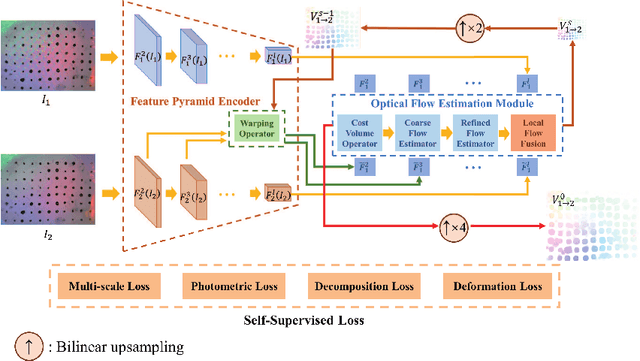
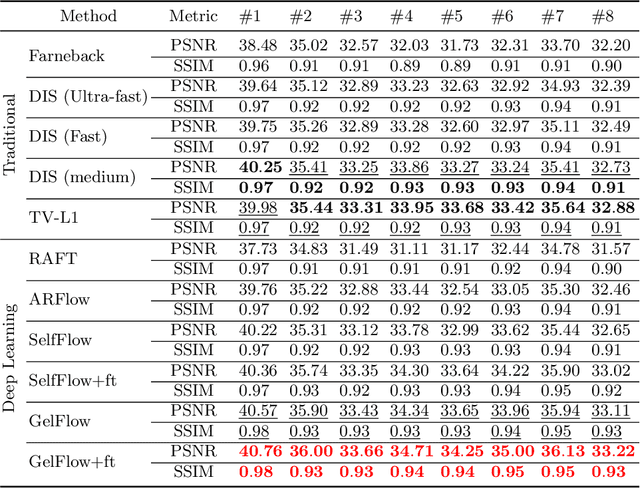
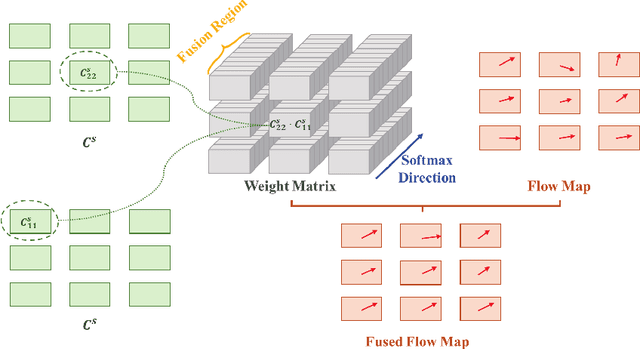
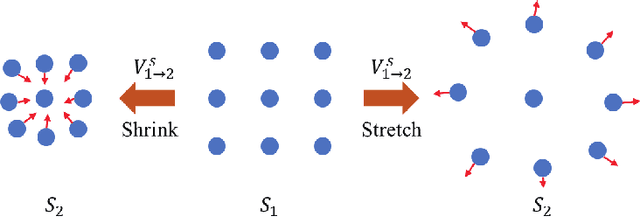
Abstract:High-resolution multi-modality information acquired by vision-based tactile sensors can support more dexterous manipulations for robot fingers. Optical flow is low-level information directly obtained by vision-based tactile sensors, which can be transformed into other modalities like force, geometry and depth. Current vision-tactile sensors employ optical flow methods from OpenCV to estimate the deformation of markers in gels. However, these methods need to be more precise for accurately measuring the displacement of markers during large elastic deformation of the gel, as this can significantly impact the accuracy of downstream tasks. This study proposes a self-supervised optical flow method based on deep learning to achieve high accuracy in displacement measurement for vision-based tactile sensors. The proposed method employs a coarse-to-fine strategy to handle large deformations by constructing a multi-scale feature pyramid from the input image. To better deal with the elastic deformation caused by the gel, the Helmholtz velocity decomposition constraint combined with the elastic deformation constraint are adopted to address the distortion rate and area change rate, respectively. A local flow fusion module is designed to smooth the optical flow, taking into account the prior knowledge of the blurred effect of gel deformation. We trained the proposed self-supervised network using an open-source dataset and compared it with traditional and deep learning-based optical flow methods. The results show that the proposed method achieved the highest displacement measurement accuracy, thereby demonstrating its potential for enabling more precise measurement of downstream tasks using vision-based tactile sensors.
 Add to Chrome
Add to Chrome Add to Firefox
Add to Firefox Add to Edge
Add to Edge